Jul 23, 2019
A weekend in Kofu, Yamanashi Prefecture, a city celebrating 500 years
Gallery - Weekend in Kofu City, Yamanashi Prefecture
The city of Kofu, capital of Yamanashi Prefecture and old Kai Province, in central Japan, this year is celebrating 500 years since its founding. The domain of storied daimyo Takeda Shingen, Kofu is compact and easy to negotiate, perhaps a reflection of Shingen’s administrative savvy. Surrounded by mountains and wineries and with abundant transport options to and from central Tokyo, a visit to Kofu makes for an easy and entertaining short trip from the Japan capital.
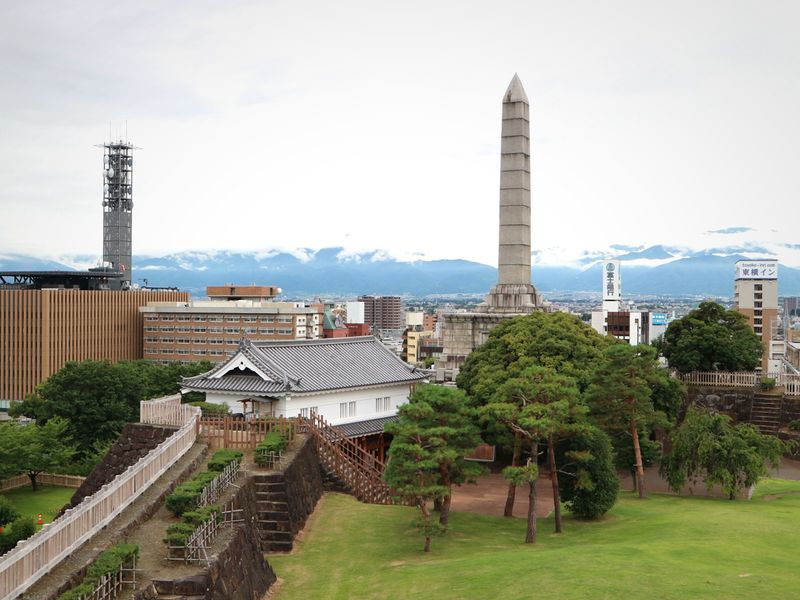
Actually we start our time in the wine-producing region of Katsunuma in the city of Koshu, about 10 km east of central Kofu.
Yamanashi Prefecture is the birthplace of winemaking in Japan, according to the city of Kofu, where the process began in the 1870s. Today the prefecture is home to around 80 wineries some 30 of which can be found in Katsunuma.
Katsunumabudokyo Station, the point of arrival for those wanting to explore the area, occupies an enviable position on the early slopes that build up into the mountains of Koshu. From the train station’s exit visitors are greeted with something of a panorama over a landscape of vineyards from which grapes have been produced for over 1300 years, including Koshu grapes (for white wine) and Muscat Bailey A (for red).
Take advantage of the lofty perch because as you follow the quiet lanes into the vineyards everything seems to exist at head-height.
For an easy introduction to the region’s wines almost directly opposite the exit of Katsunumabudokyo Station, Katsunuma Budo no Oka sits on a precipitous perch about half a kilometer from the station as the crow flies -- it’s a stiff down-and-up walk to get there though.
Budo no Oka’s primary boast is a wine cave within which around 20,000 bottles of wine, covering some 200 brands, come recommended by the experts of Koshu.
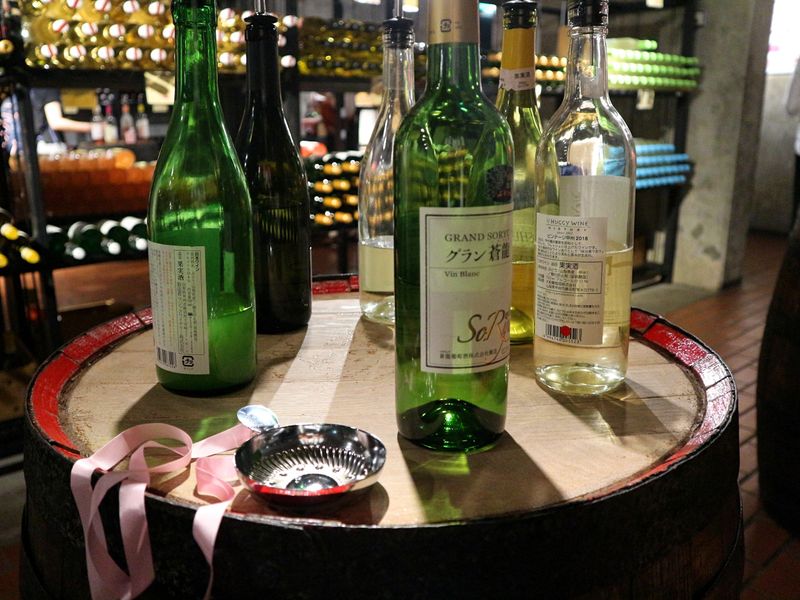
(Wines opened for tasking at the "Wine Cave" in Katsunuma Budo no Oka, Yamanashi Prefecture)
We poney up the 1,500-yen fee for the chance to taste our way around the cave’s wines courtesy of a tastevin (wine-tasting cup) which comes with the fee and can be kept as a souvenir.
As soon as we hit the early steps leading into the cave we’re hit by a thick, rich odor that reminds us of damp, well-worn socks.
Inside the dimly-lit space there must be comfortably over 50 wines that have been opened for tasting. Communal spit buckets are set to the side at regular intervals, although they were receiving scant attention during our visit as it seemed most tasters equated getting their money’s worth with getting a little tipsy. 1,500 yen feels a bit much.
Still, connoisseurs could likely spend a couple of hours down here. We’re anything but and manage to circumnavigate the cave in around 30 minutes to emerge into the light feeling the need for a nap.
We freshen up instead on Katsunuma Budo no Oka’s terrace which offers impressive views west, over a patchwork of vineyards and, from this height, Lilliputian farmhouses.
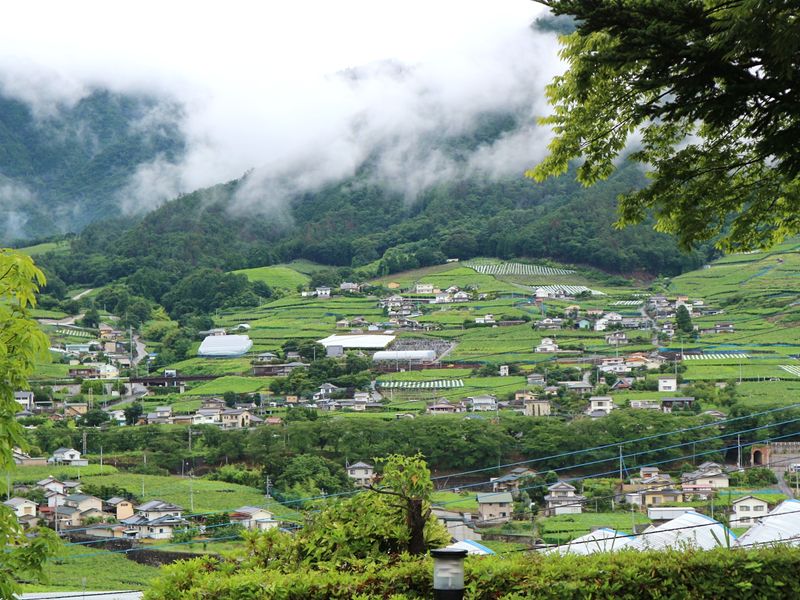
For those who want to take their wine home with them rather than drink it on the spot the facility’s shop is well stocked with wines from the region.
At the on-site restaurant Omore, you can try the local dish hoto -- a thick, rich stew of udon noodles and vegetables -- apparently a favorite with legendary local daimyo Takeda Shingen.
Entrance to Katsunuma Budo no Oka is free (even the wine cave if you’re not going to taste). Parking is tight on weekends and holidays. The walk from the station could take up to 30 minutes depending how well suited the legs are to steep slopes.
JR Chuo Line trains make the run from Katsunumabudokyo Station to Kofu Station. The journey takes around 30 mins and passes through the popular hot spring town of Isawa Onsen.
Kofu City (population nearly 200,000), the capital of Yamanashi Prefecture and formerly that of the old Kai Province, is in celebratory mood in 2019 as it marks the 500th anniversary of its founding. At the time of visiting a small exhibition has taken residence in the train station building to mark the occasion, giving visitors the basics (some of it in English) of the city’s history and their first introduction to celebrated feudal lord Takeda Shingen.
“Takeda Shingen is like an icon of the city,” a local tells us as we gaze up at the impressive bulk of Shingen’s statue just outside the station’s south exit. Every year the people here gather to celebrate Shingen’s legacy during the Shingen-ko Festival usually held in early April.
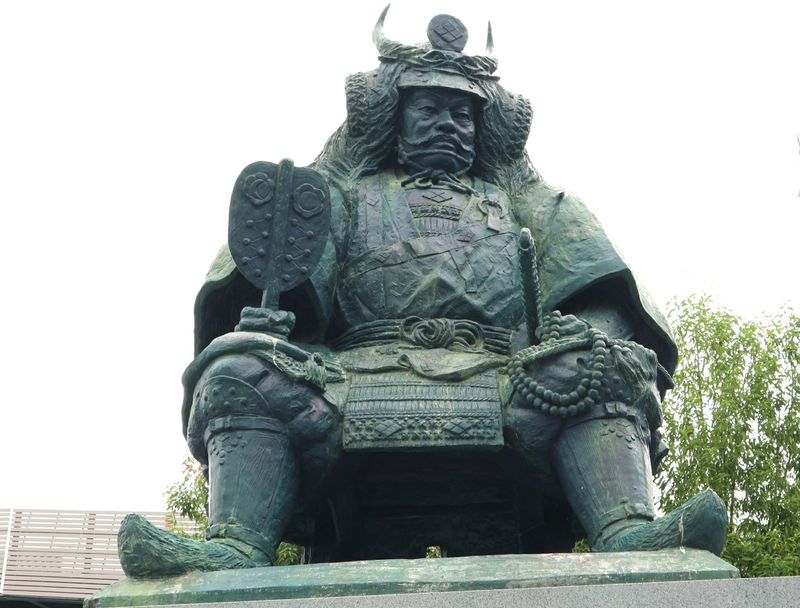
(Statue of daimyo Takeda Shingen outside Kofu train station)
One wonder’s what Shingen, military strategist and public administrator of some repute, would have thought about the current gathering in the square outside the station’s north exit where, by the looks of the psycoticaly bored, fully-grown adults gawping at smartphone screens, there are special Pokemon Go characters to find.
The gawpers are spread as far as Kofu’s charming Koshu Yume Kouji area where they idle by the collection of castle-town reproduction buildings (some have even pulled up streetside in their cards with hazards on) which houses charming eateries, craft stores, jewellers, and galleries, among others.
Particularly popular in the Koshu Yume Kouji collection is the shop / cafe Kuromitsuan Kinakotei from Japanese confectioner Kikiyo-ya, which specializes in snacks and sweets using Japan’s “black syrup,” kuromitsu, and Yamanashi souvenir staple shingen mochi -- soft rice cake coated in kinako (soybean flour).
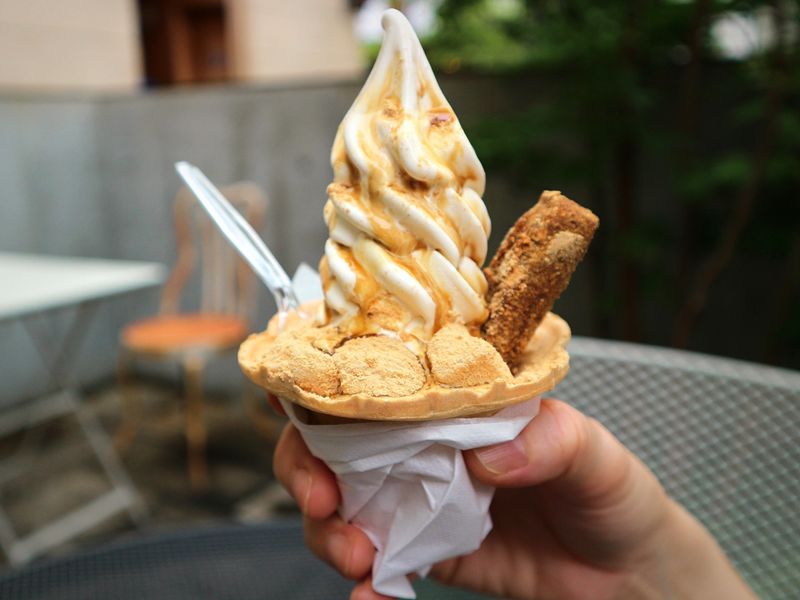
(Kikyo Shingen Soft from a cafe in the Koshu Yume Kouji area of Kofu City)
We opt for a Kikyo Shingen Soft -- soft ice cream drizzled with kuromitsu with shingen mochi at the base and a “Kikyo Shingen bar” performing the role of a 99 flake. If you’re the kind of person that typically struggles with traditional Japanese desserts, maybe this creation could restore the confidence.
With dusk approaching we head to the Maizuru Castle Park a block southeast of the train station. Here lie the ruins of 16th-century Kofu Castle. Despite the lack of a castle keep, sections of original stone walling remain along with reconstructed gates and other features.
From the top of the grounds 360-degree views can be enjoyed over Kofu to the surrounding mountains) as well as to love-struck couples smooching on the manicured grass immediately below). And the city appears completely surrounded -- something which the locals tell us contributes to the sticky summer weather, despite the moody clouds. Apparently you can see Mt. Fuji from up here on a clear day.
An attractive and manicured stone garden on the south side of the grounds belies the scrappy mood of the streets that guide us away from the grounds. It’s uninspiring stuff so we make for Kofu’s main thoroughfare south of the station, Heiwa-dori.
Kofu City Hall is about half a kilometer south of the train station along Heiwa-dori. The building has all the brute formality of an administrative center about it but on the 10th floor a quiet viewing area can be accessed free of charge so we take a pew and watch the city lights begin to twinkle as nature fades out her own.
South of Joto-dori the blocks east of the city hall as far as Yuki-dori form Kofu’s main area for dining and nightlife.
It’s a Sunday evening, around 7pm, with Monday being a national holiday but there’s not yet a great deal of action on the streets here, if there ever will be. Large tanabata decorations flutter in an otherwise quiet shopping arcade. On Sakuramachi-dori a tout standing outside one of those hostess information centers busies himself with his necktie, while besuited wedding guests armed with gift bags seek out party number two.
Kofu Gurume Yokocho (Kofu Food Village) seems to be drawing the punters though, to its collection of 18 first-floor eateries. Some of the joints here have their own seating but the communal area is where the bulk of the action lies seeming to attract families, dates, and groups.
Regular izakaya fare is the order of the day at Kofu Gurume Yokocho and we wash down our fries, ajillo, harumaki and karaage with draught beers while watching some J-league on the big-screen.
On the way back to the hotel we pass the tout outside the hostess info spot. The necktie is firmly in place but the punters are nowhere to be seen. Probably a good thing in the grand scheme of things.
Shosenkyo Gorge perhaps ranks as the must-do day trip from Kofu City. The designated Place of Scenic Beauty offers paved walking trails along side its rushing waters, waterfalls, dramatic rock formations and massive boulders a few kilometers north of downtown Kofu.
Buses for Shosenkyo Gorge depart from a stop immediately south of the train station (near the tourist information center). It takes around 30 mins to reach the bus stop at the south entrance of Shosenkyo. Two further stops (Green Line Shosenkyo and Shosenkyo Sengataki) mean the bulk of the gorge can be covered by bus.
It would take a couple of hours to walk the entire length of Shosenkyo Gorge. Those without the legs or the time should get off the bus at one of Green Line Shosenkyo or Shosenkyo Taki Ue stops and walk between the two in order to take in the highlights.
We get off at Green Line Shosenkyo and head “up hill,” going in the opposite direction to what little foot traffic there is. Shops selling local crystal and colorful stones mark the beginning of this section of the trail and we have a platoon of butterflies accompanying us on our way.
It’s easy going though, and fun to gaze up at the rock formations. A bit of poking around allows us to get close to the rushing waters. Thrusting skywards the formation called Kakuenpo is the center of attention, dominating this section of the gorge.
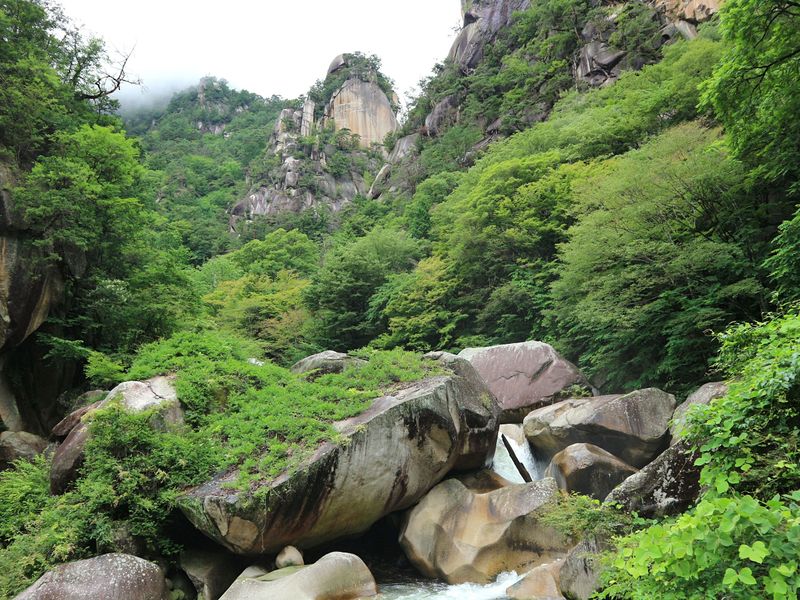
The trail crosses to the other side of the gorge on its approach to the impressive Senga-taki Falls. Above the falls is a small collection of eateries and more shops selling stones and crystal. There are a couple of petite shrines here that promise spiritual betterment by way of the area’s flashy stones.
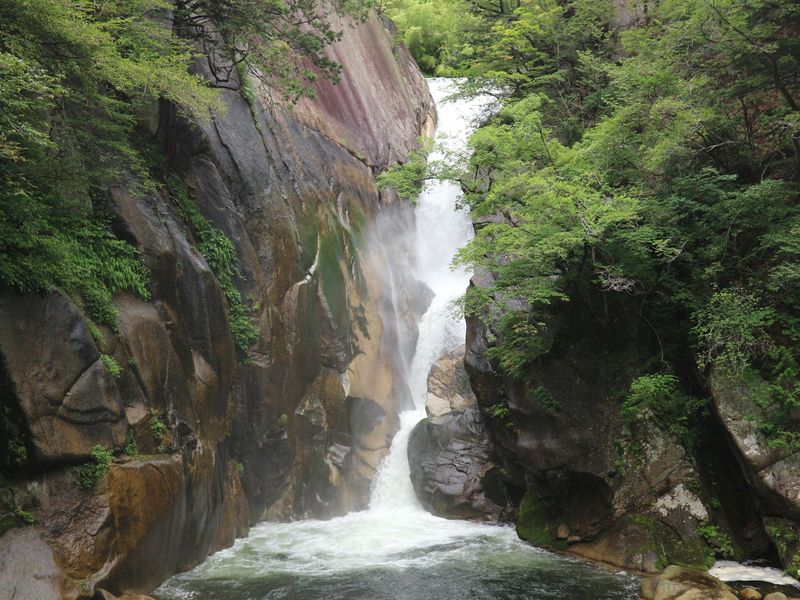
(Senga-taki Falls, Shosenkyo Gorge, Yamanashi Prefecture)
Beyond this point the gorge widens and the waters calm somewhat. The extra space has meant more in the way of shops (again with the flashy stones which are offered up like pic-n-mix candy at the movie theater) and restaurants.
The Shosenkyo Kage-e-no-mori Art Museum is up here -- the world’s first shadow art museum, supervised and designed by Seiji Fujishiro, a master of the genre.
Buses from Kofu Station to Shosenkyo stops depart from stop No. 4 outside the station’s south exit. One-way fares are as follows: Shosenkyo-guchi - 590 yen, Green Line Shosenkyo - 820 yen, Shosenkyo Taki Ue - 900 yen.
We’re back outside Kofu Station, this time the North Exit to make the short hop to Takeda-jinja Shrine, dedicated to Takeda Shingen.
This is very much tour bus territory as people come to get in touch with an icon of feudal Japan. Actually, it comes as something of a disappointment to learn that Takeda-jinja was constructed as recently as 1919. However, the shrine sits on the site of Tsutsujigasaki Palace, once home to three generations of Takeda’s.
The remaining moat and neatly manicured lawns that lie in front of the main shrine buildings would appear to reflect Shingen’s reputation of having military savvy and a sense of administrative order.
Buses from Kofu Station to Takeda-jinja depart from stop No. 2 outside the north exit of the station. The journey time is around 8 mins. One-way fares are 190 yen.
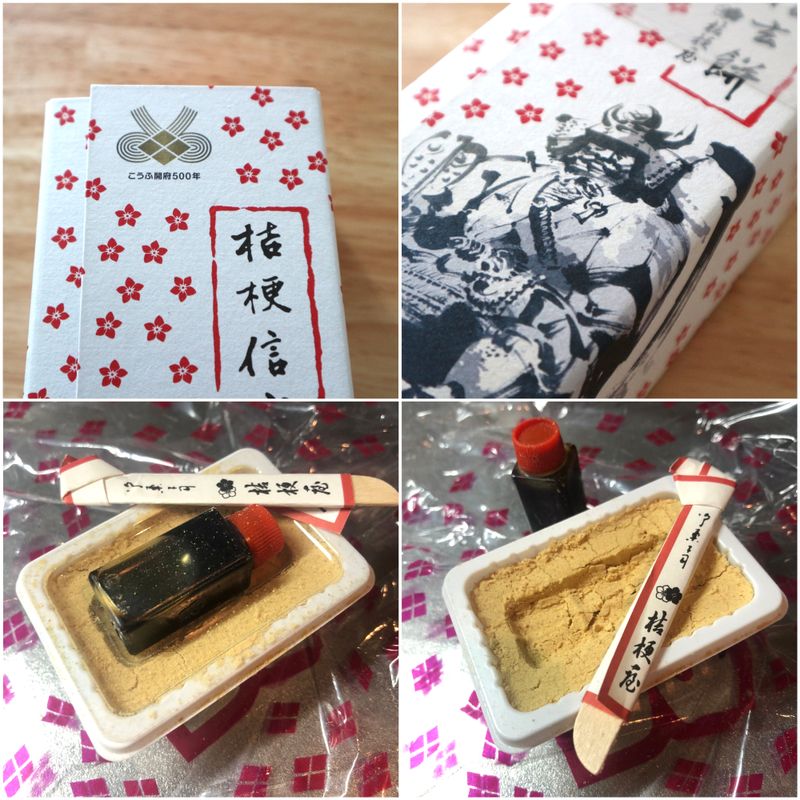
We’re on a 15:12 train service back to Tokyo so we make for Kofu Station. Outside the ticket gates sits the requisite souvenir shop doing a stiff trade. The boxes of 500th-anniversary shingen mochi look neat and tidy so we get one to take back. And then realize that shingen mochi -- each with its own Lilliputian bottle of kuromitsu -- has got to be one of the messiest of Japan’s souvenirs.
Getting to Kofu City and back from Tokyo
Shinjuku Station is the hub for train services between Tokyo and Kofu.
On the way out we used a Holiday Rapid View Yamanashi service to Katsunumabudokyo Station, which offers two decks in its carriages. That might make it sound quite fancy but the interior is pretty Spartan.
Fares were 2,070 yen one-way (including 520 yen seat fee).
The Holiday Rapid View Yamanashi service is a little elusive making only one round trip per day on weekends and holidays (usually between March and November). The journey from Shinjuku to Katsunumabudokyo Station takes around 1 hr 25 mins.
We returned from Kofu Station to Shinjuku on one of the much shinier Limited Express Kaiji services. Fares 3,820 yen one way (with reserved seat). The journey time on Kaiji services between Shinjuku and Kofu is around 90 mins.
Buses within Kofu accept IC cards such as Pasmo.
For more about how to get from Tokyo to Kofu, check out our guide below:
Tokyo to Kofu: Transport Guide
Costs for a weekend in Kofu, Yamanashi Prefecture
The costs of our weekend in Kofu City are listed below in Japanese yen. In most cases they should be considered a rough guide only and don't include sundry items like drinks from vending machines.
Day 1
| Shinjuku to Katsunumabudokyo (train) | 2,070 |
| Wine tasting at Katsunuma Budo no Oka | 1,500 |
| Katsunumabudokyo to Kofu (train) | 410 |
| Kikyo Shingen Soft | 463 |
| Izakaya dinner / drinks at Kofu Gurume Yokocho | 2,500 |
Day 2
Accommodation (business hotel), per person / per night | 4,500 |
Breakfast, convenience store bread / coffee | 500 |
| Return bus to Shosenkyo | 1,640 |
| Return bus to Takeda-jinja | 380 |
| Kikyo Shingen Parfait | 680 |
| Shingen mochi omiyage | 1,000 |
| Can of beer for the train home | 320 |
| Kofu to Shinjuku (train) | 3,820 |
Total: 19,783 yen
Do you have any experiences of travel to and around the city of Kofu? Let us know in the comments.



0 Comments